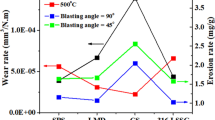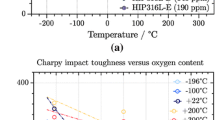Abstract
Copper dog-bone specimens are prepared by one-step spark plasma sintering (SPS). For the same SPS cycle, the influence of the nature of the die (graphite or WC–Co) on the microstructure, microhardness, and tensile strength is investigated. All samples exhibit a high Vickers microhardness and high ultimate tensile strength. A numerical electro-thermal model is developed, based on experimental data inputs such as simultaneous temperature and electrical measurements at several key locations in the SPS stack, to evaluate the temperature and current distributions for both dies. Microstructural characterizations show that samples prepared using the WC–Co die exhibit a larger grain size, pointing out that it reached a higher temperature during the SPS cycle. This is confirmed by numerical simulations demonstrating that with the WC–Co die, the experimental sample temperature at the beginning of the dwell is higher than the experimental control temperature measured at the outer surface of the die. This difference is mostly ascribed to a high vertical thermal contact resistance and a higher current density flowing through the WC–Co punch/die interface. Indeed, simulations show that current density is maximal just outside the copper sample when using the WC–Co die, whereas by contrast, with the graphite die, current density tends to flow through the copper sample. These results are guidelines for the direct, one-step, preparation of complex-shaped samples by SPS which avoids waste and minimizes machining.









Similar content being viewed by others
References
Orrù R, Licheri R, Locci AM, Cincotti A, Cao G (2009) Consolidation/synthesis of materials by electric current activated/assisted sintering. Mater Sci Eng R 63:127–287
Munir ZA, Quach DV, Ohyanagi M (2011) Electric current activation of sintering: a review of the pulsed electric current sintering process. J Am Ceram Soc 94:1–19
Vasiliev PO, Shen Z, Hodgkins RP, Bergström L (2006) Meso/macroporous, mechanically stable silica monoliths of complex shape by controlled fusion of mesoporous spherical particles. Chem Mater 18:4933–4938
Jiang D, Hulbert DM, Kuntz JD, Anselmi-Tamburini U, Mukherjee AK (2007) Spark plasma sintering: a high strain rate low temperature forming tool for ceramics. Mater Sci Eng A 463:89–93
Cai K, Romàn-Manso B, Smay JE, Zhou J, Osendi MI, Belmonte M, Miranzo P (2012) Geometrically complex silicon carbide structures fabricated by robocasting. J Am Ceram Soc 95:2660–2666
Monceau D, Oquab D, Estournes C, Boidot M, Selezneff S, Ratel-Ramond N (2010) Thermal barrier systems and multi-layered coatings fabricated by spark plasma sintering for the protection of Ni-base superalloys. Mater Sci Forum 654–656:1826–1831
Voisin T, Durand L, Karnatak N, Le Gallet S, Thomas M, Le Berre Y, Castagné JF, Couret A (2013) Temperature control during spark plasma sintering and application to up-scaling and complex shaping. J Mater Proc Technol 213:269–278
Olevsky E, Khaleghi E, Garcia C, Bradbury W (2010) Fundamentals of spark plasma sintering: applications to net-shaping of high strength temperature resistant components. Mater Sci Forum 654–656:412–415
Chanthapan S, Rape A, Gephart S, Kulkarni AK, Singh J (2011) Industrial scale field assisted sintering: an emerging disruptive manufacturing technology: applications. Adv Mater Proc 169:25–28
McWilliams B, Yu J, Zavaliangos A (2015) Fully coupled thermal-electric-sintering simulation of electric field assisted sintering of net-shape compacts. J Mater Sci 50:519–530. doi:10.1007/s10853-014-8463-1
Pavia A, Durand L, Ajustron F, Bley V, Chevallier G, Peigney A, Estournès C (2013) Electro-thermal measurements and finite element method simulations of a spark plasma sintering device. J Mater Process Technol 213:1327–1336
Zavaliangos A, Zhang J, Krammer M, Groza JR (2004) Temperature evolution during field activated sintering. Mater Sci Eng A 379:218–228
Maizza G, Grasso S, Sakka Y, Noda T, Ohashi O (2007) Relation between microstructure, properties and spark plasma sintering (SPS) parameters of pure ultrafine WC powder. Sci Technol Adv Mater 8:644–654
Maizza G, Grasso S, Sakka Y (2009) Moving finite-element mesh model for aiding spark plasma sintering in current control mode of pure ultrafine WC powder. J Mater Sci 44:1219–1236. doi:10.1007/s10853-008-3179-8
Cincotti A, Locci AM, Orrù R, Cao G (2007) Modeling of SPS apparatus: temperature, current and strain distribution with no powders. AIChE J 53:703–719
Anselmi-Tamburini U, Gennari S, Garay JE, Munir ZA (2005) Fundamental investigations on the spark plasma sintering/synthesis process: II. Modeling of current and temperature distributions. Mater Sci Eng A 394:139–148
Vanmeensel K, Laptev A, Hennicke J, Vleugels J, Van der Biest O (2005) Modelling of the temperature distribution during field assisted sintering. Acta Mater 53:4379–4388
Ritasalo R, Cura ME, Liu XW, Söderberg O, Ritvonen T, Hannula SP (2010) Spark plasma sintering of submicron-sized Cu-powder—influence of processing parameters and powder oxidization on microstructure and mechanical properties. Mater Sci Eng A 527:2733–2737
Sule R, Olubambi PA, Sigalas I, Asante JKO, Garrett JC (2014) Effect of SPS consolidation parameters on submicron Cu and Cu-CNT composites for thermal management. Powder Technol 258:198–205
Robinson P (1990) Properties and selection nonferrous alloys and special-purpose materials, ASM handbook vol. 2. ASM International, Novelty, p 267
Brindley BJ, Worthington PJ (1970) Yield-point phenomena in substitutional alloys. Met Rev 15:101–114
Zhang ZH, Wang FC, Wang L, Li SK (2008) Ultrafine-grained copper prepared by spark plasma sintering process. Mater Sci Eng A 476:201–205
Grasso S, Sakka Y, Maizza G (2009) Pressure effects on temperature distribution during spark plasma sintering with graphite sample. Mater Trans 50:2111–2114
Li W, Olevsky EA, McKittrick J, Maximenko AL, German RM (2012) Densification mechanisms of spark plasma sintering: multi-step pressure dilatometry. J Mater Sci 47:7036–7046. doi:10.1007/s10853-012-6515-y
Acknowledgements
The SEM observations were performed at “Centre de microcaractérisation Raimond Castaing - UMS 3623” (Toulouse). The authors are grateful to Dr. Ch. Guiderdoni for work on the design of the dies and to N. Ferreira, Dr. J. Huez and Pr. A. Peigney for discussions. This work was performed partly under contract NANO2C from Université de Toulouse and Région Midi-Pyrénées and partly under contract MODMAT from Université Toulouse 3 Paul-Sabatier.
Author information
Authors and Affiliations
Corresponding author
Appendix
Appendix
The Joule heating model obeys to the heat Eq. (1) and the current Eq. (2):
with E the electric field, J the current density, λ the thermal conductivity, σ the electric conductivity, Cp the heat capacity, ρ the density, and T the temperature. The relevant physical properties are given in Tables 1 and 2.
The thermal model uses two main boundary conditions. Surface radiation is governed by Eq. (3):
with ϕ r the radiative heat flux, σ s the Stefan–Boltzmann’s constant (5.6704 × 10−8 W m−2 K−4), ε the emissivity (0.80 for graphite and 0.85 for WC–Co), T a the chamber wall temperature, and T e the emission surface temperature. The heat flux at the level of the water cooling system obeys Eq. (4):
with ϕ c the convective heat flux, T w the water temperature, T i the Inconel wall surface temperature, and h c the convective coefficient (200 W m−2 K−1).
The electric and thermal contacts at the inner interfaces obey Eqs. (5) and (6):
with: J c and \( \dot{q}_{c} \) the current density and the heat flux across the contact, σ c the electric contact conductance, h cr the thermal contact conductance, and U i and, T i the electric potential and temperature on each side of the contact interface.
Rights and permissions
About this article
Cite this article
Arnaud, C., Manière, C., Chevallier, G. et al. Dog-bone copper specimens prepared by one-step spark plasma sintering. J Mater Sci 50, 7364–7373 (2015). https://doi.org/10.1007/s10853-015-9293-5
Received:
Accepted:
Published:
Issue Date:
DOI: https://doi.org/10.1007/s10853-015-9293-5




